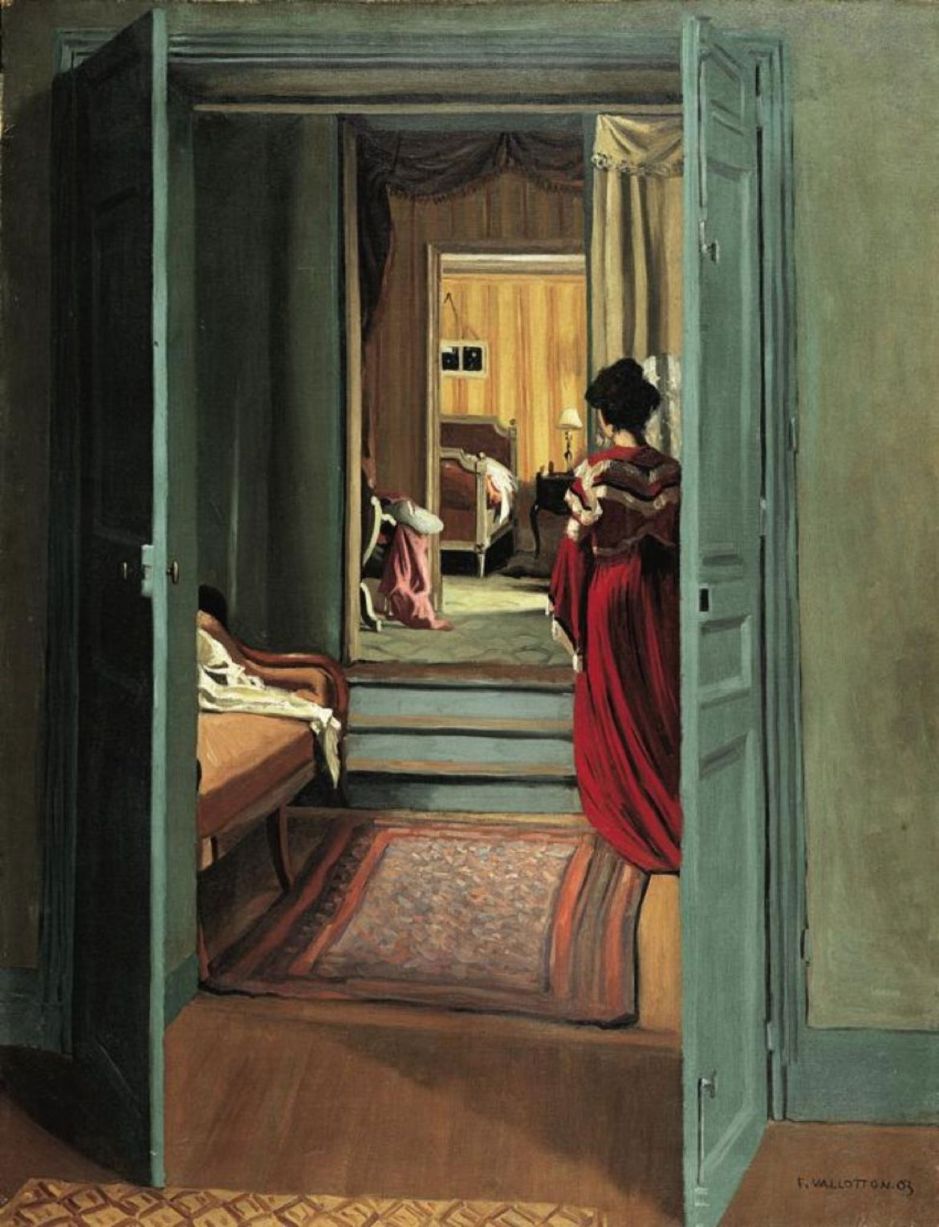In 1900, the Swiss painter and print-maker Félix Vallotton (1865–1925) was granted French citizenship. He had cut back on his prints to paint more, and the paintings that he made were no longer Nabi, but explored themes and ideas which were to be influential later in the twentieth century. He also broadened his interests: in the early years of the new century, he wrote eight plays and three novels, although none achieved much success.

Vallotton’s view of the oldest of the great bridges of central Paris, in Le Pont Neuf from 1901, is strange. Like some of the unconventional views of bridges painted in the late nineteenth century, its emphasis is on unusual perspective form, but it manages to avoid showing Pissarro’s dense throng of people, or its place among prominent buildings, and is almost unrecognisable.

It was Vallotton’s continuing series of interiors, though, which I find most fascinating. Woman Searching in a Closet from 1901 shuts out half its image with black screens and the doors to the closet, which give a strongly geometric tone. The woman, in spite of a lamp by her side, is little more than a black silhouette too, who appears to absorb the light falling on her.
The lamp itself is strange, with a shade showing some sailing ships at sea, its stand being a vertical statuette of Truth, perhaps?
A couple of years later, he painted his wife from the back as she stood searching in a cupboard of books, a work now in the Musée d’Orsay.

Maybe we should read Vallotton’s lamps more carefully. For the following year (1902), he painted this quartet of gamblers in a Poker session. Tucked away in a plush back room behind a club or bar, these four are in full evening dress, playing for stakes which could be breathtaking and bankrupting. In the centre foreground is another lamp with a patterned shade, showing sailing boats, I think.

Then in 1902-03, Vallotton painted one of the seminal records of the Nabis: Five Painters, which shows Pierre Bonnard (seated, left), Félix Vallotton (standing, left), Édouard Vuillard (seated), Charles Cottet and Ker-Xavier Roussel (standing, right).
His next views of interiors I find quite cinematic, as if stills from a movie, which perhaps reflects his very modern approach to composition and lighting, more akin to those developed by cinematographers of the future rather than painters of the past. They also appear to have been influences over the New Objectivity that developed in central Europe in the 1920s, and later American artists like Edward Hopper.

Interior with the Back of a Woman in Red from 1903 develops the framing effect of multiple sets of doors, which draw the eye deeper towards the distant bedroom. The woman wearing a red dress looks away, her skirts swept back as if she has been moving towards the three steps which divide the space into foreground and background. There are tantalising glimpses of detail on the way: discarded fabric on a settee, clothing on a chair in the next room, and half of a double bed with a bedside lamp in the distance.

There’s dispute as to whether this painting shows a Woman Reading in an Interior, as given by its French title, or a woman writing, which appears to be its translation. Vallotton painted this in 1904, and charged it with rather less mystery. But I wonder if the lower of the paintings on the wall might be one of Degas’ works showing horseriding. As usual, the single figure doesn’t show her face as she sits at the small bureau, backlit by the window and its stained glass.

Interior, Bedroom with Two Figures from 1904 is one of the last of his series of mysterious cinematic interiors, and worthy of the sub-genre of the ‘problem picture’. This is another bedroom, in which the lady of the house is standing over her maid as the latter is sewing up an evening gown for her.
The mistress stands with her back to the viewer, but her face is revealed in her reflection in the large mirror on the wardrobe at the back of the room. In that, the maid is all but invisible. These three figures appear in a perspective recession, and to the right of the wardrobe is a doorway, presumably leading through to the master’s bedroom.

In this period before the Great War, Vallotton also painted portraits, and several nudes. But the figurative painting from 1905 which I find most fascinating is this, of The Models’ Smoke Break. In an era when most adults smoked, rest periods for models, like those for other workers, were usually termed ‘smoke breaks’ even though neither woman is smoking.
Instead, one model is reclined in a pose (not a pose, as it’s a break) reminiscent of Manet’s Olympia (1863). Instead of her maid bringing her a bouquet, though, she holds a single blue flower which seems to have wilted, and chats idly to another model who sits by her feet. I wish that I could identify the paintings reflected in the mirror behind them, although I think the upper double portrait is that of Vallotton’s parents which he painted in 1886. That below looks like a coastal landscape, perhaps of Honfleur.
To follow these, Vallotton turned to paint classical myths.

